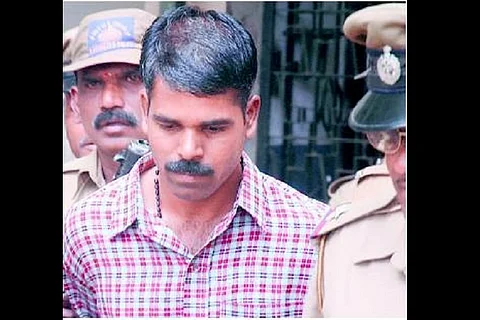

Lodged in Belagavi’s Hindalga jail, notorious rapist and serial killer Umesh Reddy awaits a death warrant that is likely to be issued for his execution. He has spent over 18 years in jail, with some stints outside when he managed to escape custody.
Umesh was first arrested on March 2, 1998, in connection with the murder of a Bengaluru woman. He made news again in 2007, when the VII Fast Track Court, Bangalore, sentenced him to death for the rape and murder of the 37-year-old Bengaluru woman in front of her son. His death sentence was confirmed by the Karnataka High Court in October 2007 and the Supreme Court in February 2011.
The Karnataka High Court, while confirming the death sentence, called Umesh a “devil”. Justice SR Banurmath, who was the third judge appointed to rule on Umesh’s sentence, said: “It is evident that even after punishments in cases of robbery, dacoity and rape, he has not reformed; no reformation can be expected from such a habitual offender and pervert criminal.”
The judge added: “I do not understand why such a devil in man’s garb should be maintained by society by locking him up in jail for life. It is a known fact that whenever there is an opportunity, he has a tendency to run away from custody and commit new, heinous crimes.
Belagavi’s Central Prison in Hindalga, is the only prison in Karnataka which has gallows. The last execution was carried out in 1983.
In the trial court, the prosecution argued that Umesh raped and murdered the woman before robbing her. The prosecution also called him a serial rapist and psychopathic killer.
Umesh was born as Umesh BA in Basappa Malige village in Chitradurga district in 1969. Much of his story beyond this point, is a sensational or perhaps sensationalised one.
By some accounts, he was posted in Jammu and Kashmir while in the CRPF, where he is said to have attempted to rape a commandant’s daughter. He was arrested, but managed to escape and return to Chitradurga.
The Hindu however, reports that Umesh was first employed as a police constable and was recruited in the District Armed Reserve (DAR) in 1996. In November-December that year, Umesh was accused of attempting to rape a girl in Chitradurga district.
Media reports vary in the number of accusations against him. In May 2002, Umesh faced 19 cases in Chitradurga, Ballari, Bengaluru, Vadodara, and Kunigal. In 2009, The Hindu reported that Umesh faced seven cases in Bengaluru alone. According to a Deccan Herald report from 2009, Umesh faced 25 cases, of which he had been acquitted in 10 and convicted in 9, but the offences of which he was convicted are not known.
Umesh is said to have murdered a string of women after raping them. He would then make off with their valuables.
In 2002, when the police arrested him after he gave them the slip on his way from Ballari to Bengaluru, the media began to claim that he was a transvestite or a cross-dresser.
A Kannada film called Khatarnak was made based on details of Umesh’s life in 2013. However, its contents have been fictionalised.
In May 2012, when Umesh filed mercy petitions with the Karnataka government, the media reported that he had faced 15 rape cases. The Cabinet, headed by the then chief minister DV Sadananda Gowda, rejected his mercy plea.
In February 2012, Umesh’s mother Gowramma filed a clemency petition with the President, which was rejected in May 2013. In her petition, she said that her son was the sole breadwinner of her family and that his brother was unwell. She also said that her son was “innocent” and that he had been picked up because the police could not arrest the real culprits.
Simultaneously, he approached the Supreme Court seeking a review of its own decision to confirm the death sentence awarded to him. This has now been rejected by the Supreme Court. Jail Superintendent at Hindalga TP Shesha told The News Minute that they had received a copy of the SC order, but the trial court had not, and that they were awaiting the issuance of the death warrant.
Director of the Centre on Death Penalty at the National Law School Delhi, Anup Surendranath, told The News Minute that the law mandated that the defence lawyer be present when a trial court issues the death warrant.
Anup said that Umesh could still challenge the death sentence awarded to him on technical grounds. He said that Umesh could challenge the rejection of his mercy petition by the President, first in the Karnataka High Court and if that failed, in the Supreme Court.
But this could be done if relevant material had not been presented to the President, or certain other grounds such as the mental health of the prisoner. He explained that in the Shatrughan Chauhan v. Union of India, two prisoners’ death sentences had been commuted to life as they were found to be unsound of mind.
Anup said that the death penalty was often “misunderstood” as a means to punish the “rarest of rare” crimes on the basis of brutality. “It is the state’s burden to show that a convict is beyond reformation, and that alternatives such as life imprisonment are foreclosed,” Anup said. He explained that the government can, by invoking certain sections of the CrPC, remit the sentence of a convict. But in December 2015, the courts interpreted the law to hold that instead of the death penalty, they would be asked to undergo life sentence, disallowing the state from invoking powers of remission.